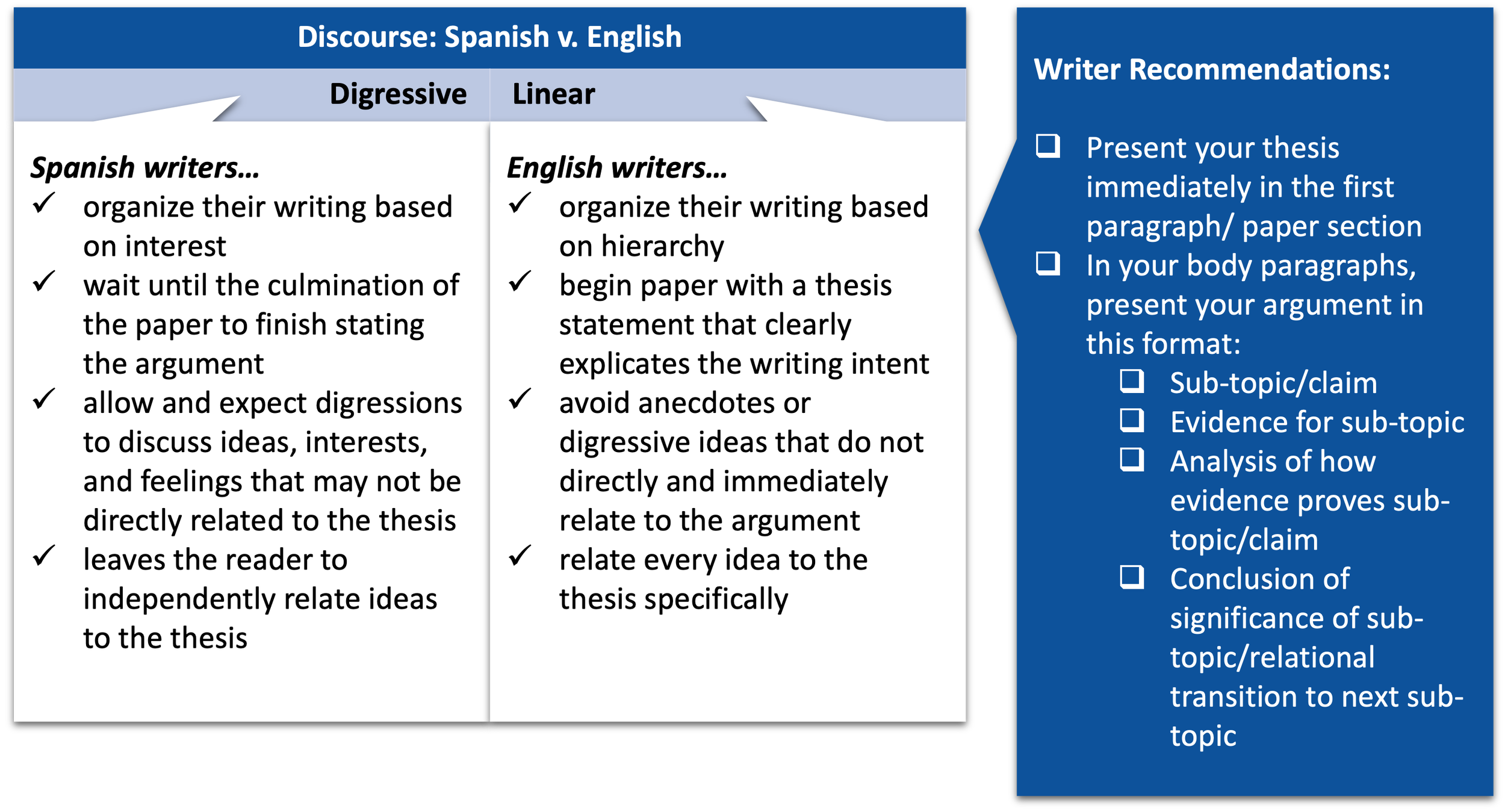
Welcome to the E3SL Writing Module!
E3SL for Multilingual Writers
The Online Campus Writing Center (OWC) acknowledges the diversity of students' educational, cultural, and linguistic backgrounds and provides specialized English writing assistance for speakers whose previous education was acquired in other languages. Along with a number of resources available to all students at TCSPP, speakers of English as a second or foreign language are offered continuous support by OWC's specialists and tutors.
In this guide, you will find writing and language support specially created to assist multilingual writers from your language background(s). Our Multilingual Writer Guide contains four modules: Grammar, Language, Writing, and Speech. You can explore these modules using the navigation bar to the left or scrolling down the page. If you are not sure where to start, click the button below for an individualized consultation with a tutor.
-
In the Grammar Module, you will find up to ten of the most common grammatical errors made by English language learners from your language background. This section is designed to assist you in quickly identifying errors that you are most likely making in your writing and to provide you with explanations of the concepts as well as opportunity to practice and improve your English language skills.
-
The Language Module contains mainly descriptive information designed to enhance your overall knowledge of the structure of both your native language and English so that you may understand where your language learning difficulties can come from. For more specific information on grammatical errors common to English language learners from your language background, continue to the Grammar Module.
-
In the Writing Module, you will find explanations for the major differences between the communication and thought styles of speakers from your native language(s) and the English language. Different languages have different expectations in communication due to the cultural shaping of language as a communication tool. This section is designed to help you understand how these differences can appear in writing so that you may learn native English writing conventions.
-
In the Speech Module, you will find information on key pronunciation differences between your native language(s) and the English language. This section also covers stress patterns and intonation use in speaking, both of which contribute greatly to sounding natural as an English speaker. Finally, this section explains common phrasal verbs, idioms, and figures of speech (non-literal language) in English. This vocabulary will help you to sound the most natural in speech and in writing and will increase your comprehension level in communication.
Need help reading this page? Install the Chrome Google Translate App on your browser for help with definitions and full page translations.
E3SL Writing Module: Writing as a Cultural Practice
Writing is a culturally informed process.
What does that mean? That means there is no such thing as one “correct” writing style or rules.
English language learners can often struggle with English writing conventions. This is not because English is very difficult but because English has very different cultural expectations in communication than their native linguistic culture. For example, some language communities have rules about how much should be said, and others have rules about how things should be said.
To help understand Western academia’s cultural expectations in writing, it is helpful to understand where this culture comes from. To do this, we will use Lewis’ (2010) three-pronged model of classifying cultures by their communication elements according to cultural behavior, cultural information usage, and cultural trust. According to Lewis, all cultures have set rules and patterns of behaviors for these three categories, so they are very useful for comparing and contrasting cultures to better understand and respect them. We will use these three categories to understand the expectations of academic writing.
According to Lewis (2010), there are three types of cultures created by different combinations of cultural behavior, cultural information usage, and cultural trust, called: Linear-Active, Multi-Active, and Reactive cultures. The chart below explains the behaviors and expectations of each of these types.
Academia as a Linear-Active Culture
As a product of Western cultures, academic writing follows a linear-active style. Reviewing the contrast between linear-active, multi-active, and reactive cultures, here are the most important characteristics of academic culture to keep in mind when understanding plagiarism.
As a linear-active culture, academia expects unemotional writing that makes its point by following a logical, deductively organized writing style.
Because academia is a data-oriented culture, it expects that all members will seek information through research and only use vetted sources.
Because academia is a high-trust society, expecting that all society members will follow societal rules and use scientific truth when making claims, citations are required on two fronts: validating what we say as true and providing credit to the scientific source honestly.
What does this look like in writing?
In writing, we can see evidence of cultural communication standards in four categories: social context, discourse style, language style, and communication purposes and goals. These categories are filled out by the culture that a writer is from. Here are the options for each category:
Social Context
High or Low Context & Indirect or Direct Communication Norms
When communicating with each other, speakers may take more indirect approaches [being careful not to say something outright that could offend another] or more direct approaches [stating exactly what they think without considering the receiver’s feelings].
Indirect cultures rely on high-context communication, meaning that much of the message relies heavily on the context and nonverbal cues because the meaning is not directly stated. In contrast, low context cultures value communication that is so direct that the context of the conversation does not matter. High-context writing requires more than what is on the page to understand it, and low context writing requires that everything needed to understand the writing be included in it.
Discourse
Linear, Anecdote-Embedded, Circular, Digressive, or Freely Arranged Text
How we organize our writing is also based on cultural convention. Writers choose to present their text in ways they feel will be appealing to the reader that they expect. There are several different styles:
Linear: unemotional, impersonal, organized by deductive logic
Anecdote-Embedded: stops throughout to share stories, usually personal in nature
Circular: avoids making a strong claim that could offend others - continues to describe the topic in different ways
Digressive: takes long deviations away from the main topic before returning to finish
Freely Arranged: discusses anything of interest in any order
Language
Elaborate or Understated Language Choices
Each linguistic community has different rules about quality and quantity of talk. This means that different cultures expect their members to keep their communication to set lengths and using set allowed levels of how familiar one can be with an audience. This can be described as elaborate vs. understated.
Elaborate: these languages allow their writers to use as many words as needed to communicate their meaning. Writers are also allowed to be very personal and emphatic or excited.
Understated: these languages want their writers to use as few words as necessary to communicate their intended meaning. Writers are also expected to remain impersonal and calm.
Purpose and Goals
Collectivist or Individualist Approach to Communication
Cultures also have either a collectivist or individualistic approach to their communication goals.
Collectivist: these cultures care about the interests and benefits of all members. In writing, they would rather be sure everyone’s needs are attended to than make their own selves happy or stand out. Others’ feelings are considered in deciding how to say something.
Individualistic: these cultures care about individual advancement. In writing, they present strong, opinionated arguments that can often explain why others are wrong using direct language. Others’ feelings are not considered as more important than personal advancement.
Academic English
Social Context
Low Context
Discourse Style
Linear
Language Style
Understated
Purpose & Goals
Individualistic
Using this information, multilingual writers can predict where their writing style might agree or conflict with academic English. There is a simple checklist to use as well to explore these differences.
After answering these questions, multilingual writers can identify where there are large expectation differences in writing in their native language and academic English. By expecting these differences and explaining how they create different writing styles, multilingual writers can share their meaning more clearly by understanding what is expected of them.
In the following sections, the major differences between English academic writing expectations and other linguistic cultures will be examined:
Spanish and English
French and English
Chinese and English
Japanese and English
Korean and English
Italian and English
German and English
Take Our Cultural Behavior Personality Quiz!
Find out how your cultural background affects your writing style
E3SL Writing Module: Spanish-English Guide











